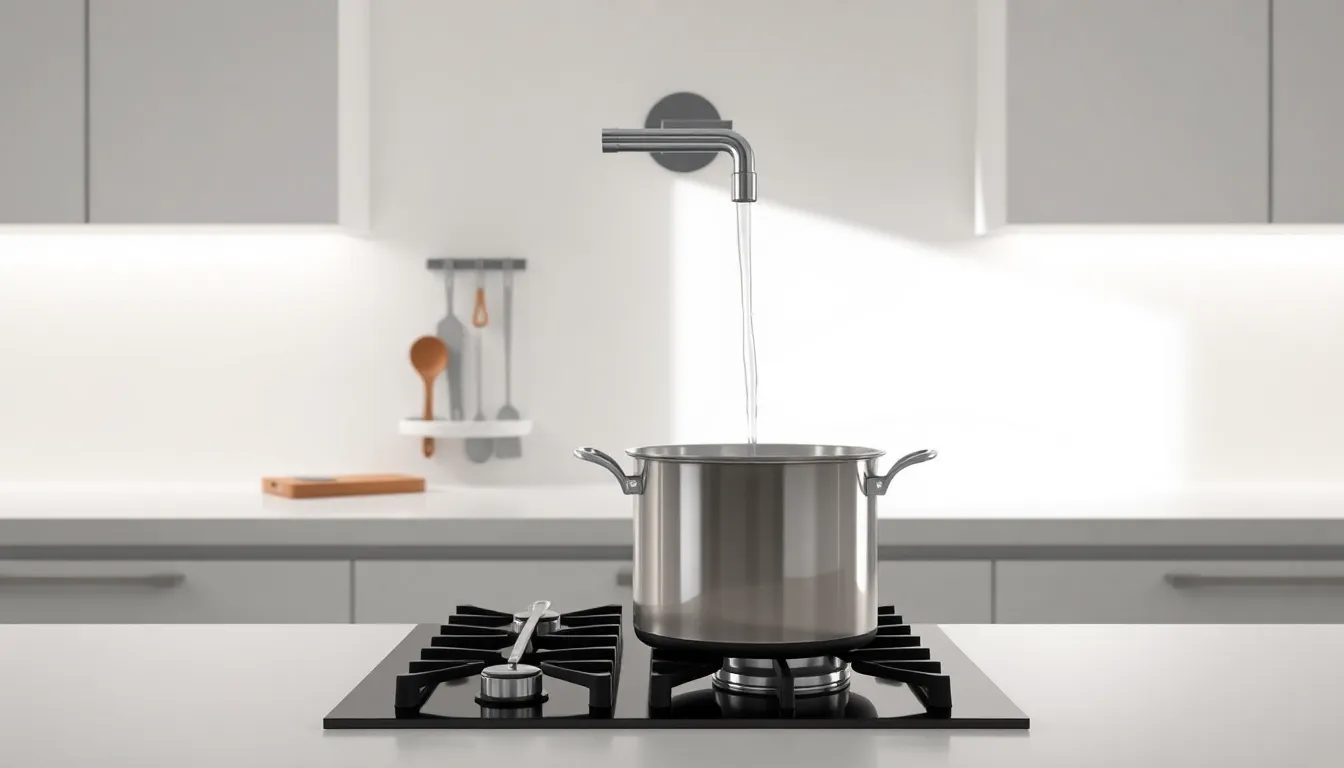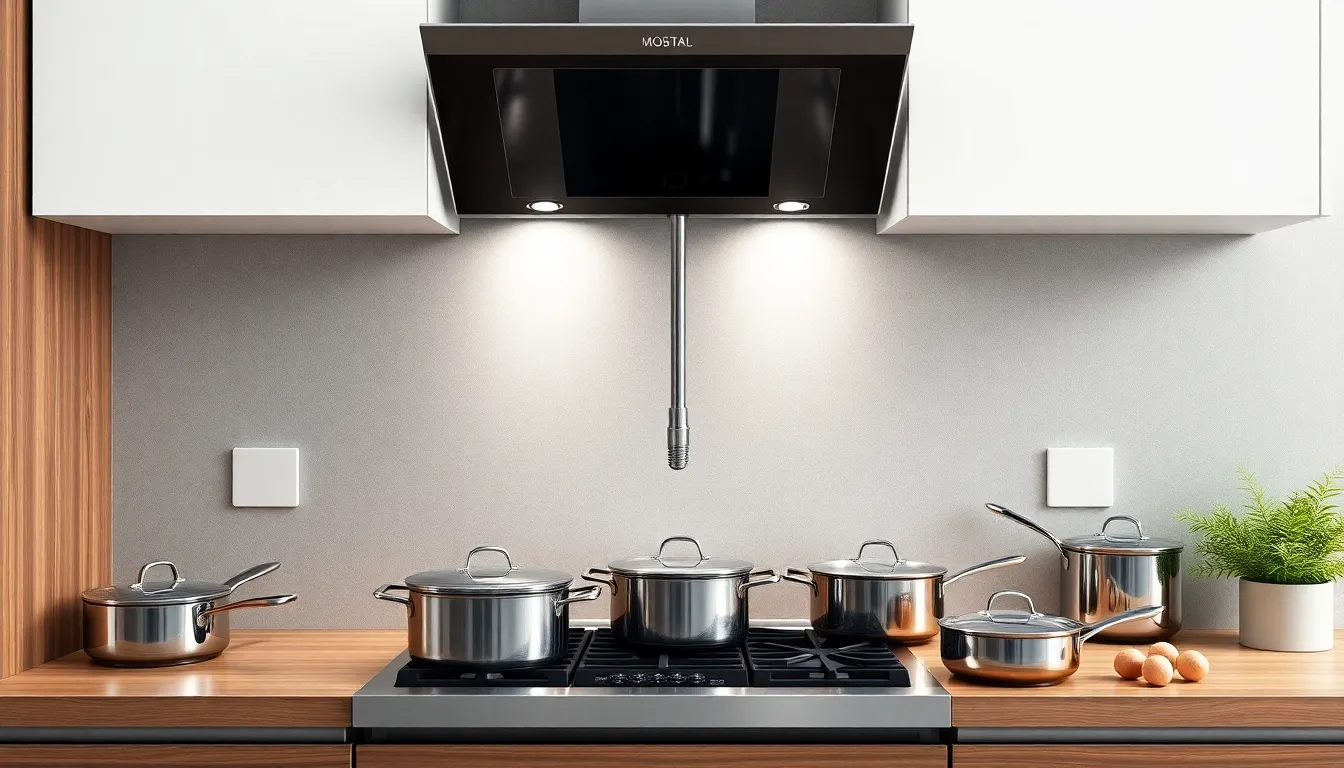
Imagine whipping up a gourmet meal without the hassle of lugging a heavy pot across the kitchen. Enter the pot filler—a kitchen hero that’s both stylish and practical. This nifty fixture not only elevates the look of any culinary space but also saves time and effort. Who wouldn’t want to fill a pot right on the stove?
With a pot filler, cooking becomes a breeze. No more awkward balancing acts or spills on the way to the stove. Just a quick flick of the faucet and voilà! Whether you’re a seasoned chef or a weekend warrior, this handy addition could transform your cooking experience. Let’s dive into the world of pot fillers and discover why they’re the unsung champions of modern kitchens.
What Is a Pot Filler Kitchen?
A pot filler kitchen features a specialized faucet designed to fill pots directly on the stove. These fixtures mount on walls above the cooking surface for easy access. Convenience stands as a primary advantage; home cooks no longer need to carry heavy pots from the sink to the stove.
Pot fillers often come in various styles, adding both functionality and aesthetic appeal. Many homeowners choose to install them for the sleek, modern look they provide. Several models offer features like extendable spouts, allowing users to reach pots of different sizes.
Installation usually involves connecting the pot filler to the hot and cold water supply lines. Such setup ensures cooks can adjust water temperature as needed. Additionally, pot fillers may incorporate safety features, such as backflow prevention, which protects the water supply.
Efficiency in the kitchen improves significantly with this addition. Users save time and effort when filling large pots, especially during meal prep for gatherings. Many chefs appreciate the ability to multitask while cooking, as pot fillers streamline the cooking process.
Environmental benefits also exist. Using a pot filler reduces the likelihood of water waste during cooking. It encourages cooks to use only what is required, minimizing excess water consumption.
Overall, the pot filler kitchen enhances both the functionality and style of cooking spaces. As a result, these fixtures have gained popularity among those who prioritize a practical yet chic kitchen design.
Pot Filler Kitchen

Pot fillers offer significant advantages for any kitchen design. Their functionality and style enhance the cooking experience, making meal preparation more efficient.
Convenience in Cooking
Convenience remains a top benefit of a pot filler kitchen. Users can fill large pots directly on the stove without the need to transport them from the sink, reducing the risk of spills. Cooking becomes more efficient with easy access to water while preparing pasta or boiling vegetables. A pot filler also allows for quick and effortless temperature adjustments, as it connects to both hot and cold water supply lines. The strategic placement above the stove ensures that home cooks can reach it comfortably while multitasking. Overall, the addition of a pot filler simplifies the cooking process, saving time and effort during busy meal preparations.
Space-Saving Design
A pot filler’s design contributes to maximizing kitchen space. Wall-mounted fixtures eliminate the need for bulky faucets or additional sink installations, creating a cleaner, more streamlined look. By keeping countertops clear, pot fillers provide more surface area for food preparation and cooking. This design is especially beneficial in smaller kitchens where every square inch counts. Efficient use of vertical space allows for better organization, enhancing the overall functionality of the area. Homeowners appreciate the aesthetic appeal, as pot fillers often come in various styles that complement kitchen decor. Thus, they improve both form and function in limited spaces.
Types of Pot Fillers
Pot fillers come in various designs to suit different kitchen styles and needs. Each type offers unique benefits.
Wall-Mounted Pot Fillers
Wall-mounted pot fillers attach directly to the wall above the stove. This design saves counter space, creating a minimalist look. Often featuring an extendable spout, they allow cooks to fill pots directly on the cooking surface. Backflow prevention is a common safety feature, ensuring water remains uncontaminated. Many homeowners opt for this style for its aesthetic appeal, often matching decor through finishes like chrome or brushed nickel. For users who prioritize convenience, wall-mounted pot fillers provide effortless access to water and enhance kitchen efficiency.
Deck-Mounted Pot Fillers
Deck-mounted pot fillers sit on the countertop adjacent to the stove. Having a more traditional appearance, they add a classic touch to kitchen designs. The accessibility of a deck-mounted style allows quick filling of pots while cooking. Homeowners appreciate the added flexibility since this type can be placed wherever most convenient. Options include swivel spouts, which further improve functionality by providing a broader range of motion. Many also come with single or dual handles, allowing for easy temperature control. Overall, deck-mounted pot fillers blend practicality with design harmony.
Installation Tips for a Pot Filler Kitchen
Installing a pot filler in the kitchen requires careful planning and execution. Each step significantly impacts the overall functionality and aesthetic of the kitchen.
Plumbing Considerations
Plumbing plays a crucial role in pot filler installation. Ensure connections to hot and cold water supply lines meet local plumbing codes. Consider using flexible plumbing lines, which simplify the installation and allow adjustments as necessary. A licensed plumber can provide insights into water pressure requirements, preventing potential leaks and water flow issues. Additionally, backflow prevention devices help maintain water quality by stopping contaminants from entering the potable water supply.
Location and Height
Choosing the right location enhances the usability of the pot filler. Mount the faucet directly above the cooking surface for convenience. Consider positioning it near the rear of the stove to avoid interference with pot handles. Height is equally important; installers recommend positioning the spout approximately 20 inches above the cooktop for effective filling without splashing. Clearances should also accommodate taller pots while ensuring easy access. Proper location and height maximize the benefits of the pot filler, blending function and style seamlessly.
Conclusion
Incorporating a pot filler into a kitchen design not only enhances functionality but also elevates the overall aesthetic. These fixtures streamline cooking by providing direct access to water, making meal prep quicker and more efficient. With a variety of styles available, homeowners can choose a pot filler that complements their kitchen decor while enjoying the practical benefits it offers. Proper installation ensures optimal performance and safety, allowing cooks to focus on creating delicious meals without unnecessary hassle. A pot filler is more than just a convenient tool; it’s a stylish addition that transforms the cooking experience.



